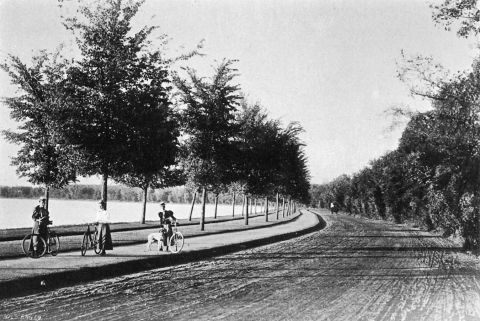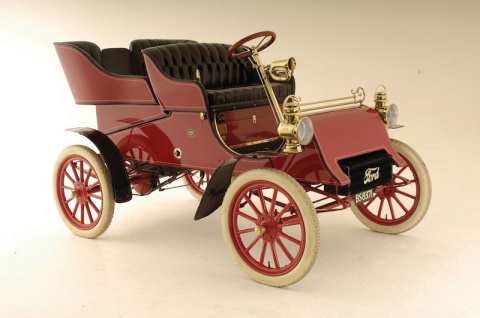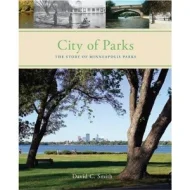Park Progress: 100 Years of Engines, Wheels, Automobiles and Metropolitan Parks
Writing one hundred years ago this week, then Minneapolis park board president Edmund Phelps, made several observations in the park board’s annual report for 1912 that attracted my attention.
“I notice in the Board’s report, especially between 1894 and 1900, frequent references to our bicycle paths and the very general use of the bicycle itself. It will be remembered that at one time there was great agitation for fine bicycle paths upon all main thoroughfares. During the last few years there has been nothing said in the reports and there has been no attention paid to keeping up bicycle paths for the reason that the use of the wheel, unfortunately, was very largely diminished.”

This is one of my favorite park photos. It first appeared in the Minneapolis park board’s 1896 annual report. It shows bicycle paths around Lake Harriet created that year. The layout of walking path, bicycle path and carriage way, there were no cars yet, is almost identical to today. (Minneapolis Park and Recreation Board)
The “wheel,” as Phelps called the bicycle, has made quite a comeback. Bicycle riders were generally called “wheel men” then although as this picture demonstrates riding bicycles was not strictly a male pursuit. Perhaps most remarkable however, despite the fact that today you could spend more on a bicycle than the park board paid for Lake Calhoun, the basic concept of the bicycle has not changed at all: two wheels on a connecting frame, pedals, seat, handlebars—and a dog out for exercise.
Another thematically related passage from Phelps’s 1912 report is worth noting.
“We ought not to mow forty acres of lawn at Lake of the Isles by handpower, but the best power lawn mowers, such as are used by parks and country clubs, should be provided, as they facilitate the work and reduce greatly the expense per acre.”
I have no idea if Phelps was a stockholder in The Toro Company.
Greater Grand Rounds
Finally, Phelps recommended an idea that was not new, but was placed in an automotive context I haven’t seen before. Writing thirty years after the creation of the park board, Phelps looked thirty years into the future and foresaw,
“Two or three trunk lines of excellent highway will connect the eastern and western extremities of our great country. Good roads of high class construction will prevail throughout every state of the Union. While these state roads should and will radiate from the large cities of the commonwealths, yet all will connect in a nearly direct line with the nearest transcontinental highway.”
Combining the development of good roads for automobiles with his prediction that there would be more than a million people in the Twin Cities in thirty years (1943), Phelps wrote,
“Long before that time the boulevard system of the two cities should be extended so as to make one ‘Greater Grand Rounds’ of one hundred miles or more.”
Phelps then described a parkway system that followed Minnehaha Creek to Lake Minnetonka, around that lake, then south from Excelsior to Shakopee, down the Minnesota River valley and its “enchanting scenery” to Fort Snelling, through St. Paul to and around White Bear Lake, then to Anoka and the Mississippi River, passing many beautiful lakes on the way,” then back to Minneapolis along the river. Phelps concluded,
“I am sure that a boulevard similar to the one suggested eventually will be built. An enabling act should be prepared and presented to the Legislature at the present session, and passed, so that the work may be prosecuted later.”
The parkway Phelps recommended was never authorized or built, but parks have been acquired along much of the route he suggested.
The First Automobile Ordinance
Phelps vision of automobiles, transcontinental highways and “Greater Grand Rounds” is not surprising given his early adoption of the automobile himself.
Phelps first appearance before the park board, more than a year before he was elected to be a park commissioner, was on behalf of the Automobile Club of Minneapolis. On May 7, 1903 Phelps requested permission for the club to have an automobile hill-climbing contest on the steep hill on Kenwood Parkway near Spring Lake. Hill-climbing contests were an early form of car racing, seeing whose car could climb a steep hill in the shortest time. As an inducement for approval of the club’s request perhaps, Phelps invited park commissioners and friends to attend the contest and afterwards be given a ride by automobile around the parkways.

1903 Model A Ford. It also came in a two-seat version. It was manufactured only in red. It had a top speed of 28 mph. (americanfords.com)
Phelps’s request for use of the parkway was approved, but he may have gotten more than he bargained for. Immediately following approval of his request, the board directed the Privileges and Entertainments Committee to meet with the City Council Committee on Ordinances to develop an ordinance governing the use of automobiles in parks.
The park board subsequently passed an automobile ordinance on June 20, 1903. The ordinance restricted automobile speeds to 15 miles per hour, required that each car powered by gasoline have a muffler, that each car have a bell or horn, and a have at least one lighted lamp if operated after dark. In addition,
“Every person operating an automobile shall stop upon request or signal from any person in charge of a horse or horses, and shall also stop whenever a horse or horses show signs of fright at the automobile.”
Anyone convicted of violating the ordinance was subject to a fine of $2-$100 and, if in default of payment of a fine, imprisonment in the City Work House for a period of up to 90 days.
To give you some idea of how new cars were at the time, the Ford Motor Company was incorporated only four days before the park board’s automobile ordinance was passed in June 1903 and Ford’s first three Model A’s were manufactured the next month. The success of those vehicles is still evident in Minneapolis where we refer to the Ford Dam and Ford Bridge, named for their proximity to and relationship with the Ford assembly plant in St Paul. The construction of the Ford Bridge made Minnehaha Park easily accessible to St. Paulites.
David C. Smith
© David C. Smith

[…] That post addressed the coming of cars to Minneapolis parkways and the increasing importance of automobiles—with a comment on bicyles and horses on parkways, too. […]